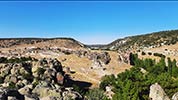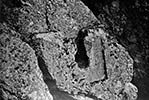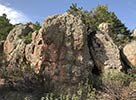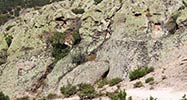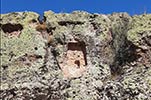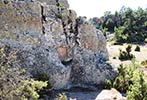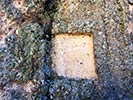Fındık is a large Phrygian settlement located near Fındık village about 25 km northeast of Kütahya. It is one of the most noticeable Phrygian sites in the highlands region together with Göynüş and Yazılıkaya. It is situated in a narrow valley, on a small stream which flows north into a tributary of Porsuk. The northern part of the site is occupied by the kale, called Fındık Asar Kale (or Kaya). It is a large fortress built on a rocky elevation in a narrow valley at the south of Fındık village. The fortress can be reached by two separate stairs, one on the south and the other on the west side of the plateau. There are traces of numerous structures inside the kale, as well as many façades, niches, altars and rock tombs scattered around the fortress and the valley.
Click on the pictures for larger images.
Façade 2
Image sources:Shaft Monument (Façade 1)
It is located approximately 370 m south of Asar Kale, built at the bottom of a slope. Haspels says it's a shaft monument. However, in comparison to all the other shaft monuments, it is much smaller in scale that some researchers classify it as a niche rather than a façade. The space behind the niche is rather small for a typical shaft. It is only 95 cm deep. Also, the front face is not in the appearance of a house façade. The rock face is flattened in square shape but there is not any workmanship other than a frame that surrounds the three sides of the surface. In addition, unlike other façades, it starts approximately 1 meter above the ground level. Due to natural conditions as well as possibly destruction by treasure hunters, the middle section of the niche and the upper left side of the façade frame have completely disappeared. About 5 m to the right of this monument, there is a stepped altar (Altar 1).
It is located on the rocks facing the Fındık stream about 200 m northeast of the shaft monument. It was discovered by E. Brandenburg while conducting a research in the region between 1901 and 1904. The façade was engraved on the flattened surface of a 4.5 m high rock. Inside the frame at the top there is an inscription (W‑06), in which only the name of the goddess Matar could be read. Both the inscription and the surface of the monument are highly weathered and eroded. In addition, the back wall and the floor of the niche were carved by treasure hunters. Ten altars and five idols were found scattered on the rocky slope around the monument.
Niches
There were five significant niches identified in the Fındık region. Three of them are located in the area between the shaft monument and Façade 2 at about 30-40 m intervals. About 250 m north of these, to the west of Asar Kale, are the other two built side by side on the same rock. Above these two niches is also a badly weathered rock relief. On one of the niches in the south (Niche 3), there is a highly weathered Old Phrygian inscription (W‑07).
Niche 1 & 2
Altars/ Stepped Monuments
In the Fındık Asar Kale region, there are more than 30 catalogued altar monuments scattered throughout the valley. Most significant ones are shown here. A few other barely visible and hard to photograph monuments (whose numbers are skipped below) are not included in the list. Besides, Tamsü (2004) notes at least 11 more altar monuments that have not been catalogued.
Altar 1 (Berndt-Ersöz No:42; Tamsü Kat.No:53; Tüfekçi-Sivas No:2)

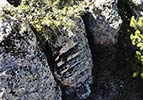



Altar 2 (Berndt-Ersöz No:43; Tamsü Kat.No:54; Tüfekçi-Sivas No:3)



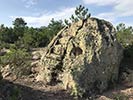
Altar 6 (Tamsü Kat.No:58)



Altar 8 (Tamsü Kat.No:60)



Altar 9-10-11-12 (Berndt-Ersöz No: 44-45-46; Tamsü Kat.No:61-62-63-64)

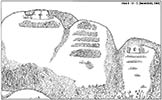

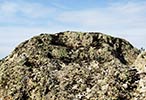
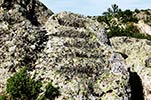


Altar 13 (Tamsü Kat.No:65)

Altar 14 & 15 (Tamsü Kat.No:66 & 67)
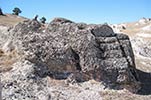
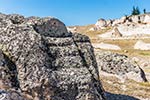

Altar 16 (Tamsü Kat.No:68)
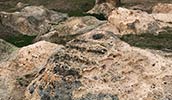
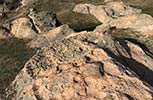
Altar 17-18-19 (Berndt-Ersöz No:17; Tamsü Kat.No:69-71-70)
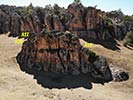




Altar 20 (Berndt-Ersöz No:52; Tamsü Kat.No:52; Tüfekçi-Sivas No:1)


Rock-Cut Tombs
There are many rock tombs, mostly on the plateau and slopes to the west of Asar Kale. To the east of the Asar Kale, there is a 3-bed tomb built on a rocky height, standing on the opposite side of the Fındık stream. Haspels classifies all of the tombs in Group I (see Descriptions).
Doğuluşah Kale
It is on a rock called Asar Kaya to the north of Doğuluşah village of Kütahya, about 3.5 km southwest of the Fındık Asar Kale. The site was in use even after the Phrygian period.

References:
Berndt-Ersöz, S. 2006. Phrygian RockCut Shrines. Structure, Function and Cult Practice, Leiden.
Berndt-Ersöz, S. 1998. 'Phrygian Rock-Cut Cult Façades: A Study of the Function of the So-Called Shaft Monuments', Anatolian Studies 48, 87-112.
Brandenburg, E. 1906. 'Neue Untersuchungen im Gebiet der phrygischen Felsenfassaden', Abhandlungen der K. B. Akademie der Wissenschaften 23, 637716.
Haspels, C. H. E. 1971. The Highlands of Phrygia. Sites and Monuments, Princeton.
Radt, W. 1993. 'Ein phrygisches Felsmonument?', IstMitt 43, 299303.
Sivas, H. 2012. 'Phrygian Rock Cut Tombs', in Phrygians, In the Land of Midas, In the Shadow of Monuments, eds. T. Tüfekçi-Sivas & H. Sivas, İstanbul.
Tamsü, R. 2004. Phryg Kaya Altarları, (Eskişehir- Afyon-Kütahya İlleri Yüzey Araştırması Işığında), Unpublished MA thesis, Anadolu Üniversitesi, Eskişehir.
Tüfekçi-Sivas, T. 1999. Eskişehir-Afyonkarahisar- Kütahya İl Sınırları İçindeki Phryg Kaya Anıtları, Anadolu Üniversitesi Yayınları No:1156, Eskişehir.
E. Brandenburg, 1906
C. H. E. Haspels, 1971
W. Radt, 1993
R. Tamsü, 2004
S. Berndt-Ersöz, 2006
H. Sivas, 2012
Ertuğrul Anıl, 2020
Bora Bilgin, 2020
Tayfun Bilgin, 2020
Reha Özer, 2020
